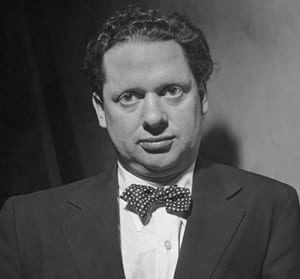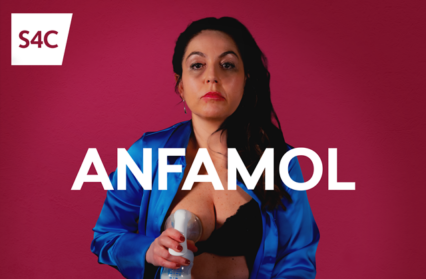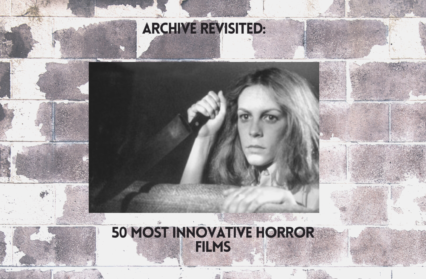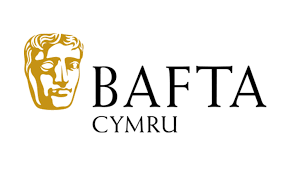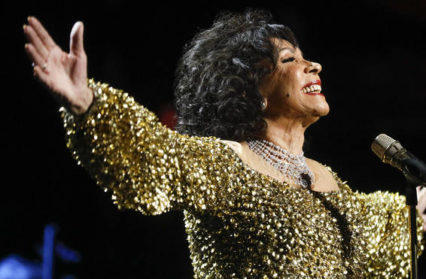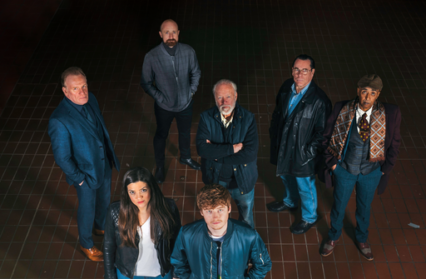In celebration of the centenary of Dylan Thomas‘ birth, Adam Somerset looks across a range of media to see how others remember the bard.
The Dylan Thomas centenary has launched a thousand events. Dylan Thomas A Poet’s Guide is one with a difference. It is about the poetry. It is presented by an authoritative voice who knows the subject. A film about a poet gets to be actually presented by a poet, who meets a range of speakers who are also poets. Qualified people who know, and care about, the subject; it is quite a good idea for a documentary.
Owen Sheers eschews hagiography. At the start he acknowledges the critical view of the verse that it is ‘showy… overblown… turbocharged.’ His own view is forthright: ‘the most original poetic visionary of the last hundred years.’ Producer-director Ian Michael Jones eschews all the fashion items that disfigure the documentary genre – no overblown score, no MTV-speed editing. He lets his presenter sit at a table with a copy of The Listener of 14th March 1934. Sheers walks into the bedroom at Cwmdonkin Drive, speaks, glances across to the window with its view of a blank wall. He stands over the teenage notebooks that were to provide material for poetry that persisted long into the adult life.
He gets the critique right. It is not about what a poem means but how it means. Thomas wants his verse to be ‘a sensory event’. Sheers identifies, recognises the importance of the wartime service with the three poems on the bombing of British cities. Andrew Motion is reader and explicator for ‘A Refusal to Mourn the Death, by Fire, of a Child in London’. Sheers walks the Carmarthenshire lane to the farmhouse where ‘Fern Hill’ was written. John Goodby locates it in its time of writing. It is a poem of peace written in September, 1945. Arriving eventually at ‘Do not go gentle…’ its accomplishment, says Sheers, is to ‘make people feel poetry has some use in the world.’
The short last period of celebrity across the Atlantic casts a glitzy shadow over the life in Laugharne and London. ‘In February, 1950 Dylan Thomas stepped onto a plane bound for America,’ runs the script; ‘and poetry stepped into the mass media age.’ ‘The Chelsea Hotel and the White Horse are stations of the cross but the myth has obscured the verse.’ Thomas may have done one hundred and fifty public readings in the USA but he still had to schlep his own suitcases. He was rude about his own performance voice calling it hammy and Charles Laughton-esque. He had not done badly at home, Sheers reminds us. ‘Deaths and Entrances’ had sold ten thousand copies when Thomas was only aged thirty-one.
The music for Dylan Thomas: A Poet’s Guide divides; piano for Wales, a snappy jazz score for the USA. Poets read, comment and add texture. Gwyneth Lewis reads a poem that she confesses to finding difficult but is ‘so knowing about what is losing’. Clare Pollard: ‘He’s so unembarrassed, there’s a boldness to it.’ Paul Muldoon feels a sense of timelessness as if they had made themselves. But a lot of banging and sawing has gone into their making. He looks at a worksheet that reveals the alteration from ‘sings’ to ‘spins his morning of praise’. Other illuminating comment comes from Menna Elfyn, Jo Shapcott and Simon Armitage.
That shed, in its replica form, has been hauled to and fro across Wales this year. Just six poems were written in it, adds Sheers. Accuracy matters.
*
The primary impression left by Under Milk Wood in Pictures: Peter Blake Does Dylan is that the production team has scant interest in either poetry or art. The script is lazy, the interviewees uninformative, the off-screen narration matey in tone tending to the gauche. ‘Peter,’ the voice tells us, ‘will never know what Dylan thinks about his artworks.’ Well, no. The artist was only aged twenty at the time of the poet’s death. Jeff Towns, a voice of authority, becomes in this laddish script ‘the ultimate Dylan know-it-all.’
The lack of interest in the art is established at the outset of this centenary piece. In place of saying something about the art of Peter Blake the script, on autopilot, declares it ‘defined an era’. With a liking for the phrase it declares a few minutes later that he ‘defined a generation’. The choice of interviewees is a celebrity chase. Weathered rock greats provide an excuse to digress for a film clip of a sixties hit. ‘Dylan was the world’s hip hop artist although he didn’t know it himself,’ opines a good singer but not so great a literary commentator.
As for the art of Peter Blake, the subject of the film, the rapid editing of the pictures allows it a small fraction of the film time. The camera prefers to pan over the images so they are rarely seen in their entirety. In this view, of this metro-centred script, Laugharne is ‘remote and isolated’, ‘a town full of characters’, ‘a mad place’. The researchers, if there were any, might have pointed out it is four miles from a railway line and close to the ancestral Thomas home. The whole uncertain, uninterested film is capped with a lot of over-insistent plinky plonky music that irritates.
The Dylan Thomas centenary has launched a thousand events. This one is a fighting contender for the prize as the most half-hearted and indolent. As a footnote the script in its fawning Boy’s Own celebrity wallow omits all mention of woman artist Jann Haworth in the making of the Sergeant Pepper cover.
*
Welsh Greats from BBC Cymru Wales is a workable and useful documentary on the life in its entirety for the centenary. Director Dafydd O’Connor has passed on the use of a presenter – never a good idea – but has secured the service of Matthew Rhys for narration. The range of interviewees marries archive material, Caitlin Thomas and John Ormond, with present day commentators. Jeff Towns, Hannah Ellis, Gwen Watkins, biographers Paul Ferris and Andrew Lycett all contribute. Julia Cleverdon tells that Under Milk Wood probably only exists by virtue of her father’s strong-mindedness. Producer Douglas Cleverdon locked the author up for the night and forced it out of him.
The film is crisply edited, following the trajectory from boyhood to school magazine editor to the publishing of 18 Poems. The first collection is published, at the poet’s insistence, without photo or blurb. The meetings with Pamela Hansford Johnson and Augustus John follow and the film tracks the life’s locations from ‘The Wheatsheaf’ to the New Forest to Laugharne. A perfect retrospective for the centenary, extracts from the most celebrated poems are heard in that unmistakable voice. An interviewee reveals that the speaking voice, a light tenor in private, wholly differed from the public voice.
The film does not shrink from the flaws. The marriage entailed acts of physical violence. Parenting was remote and occasional. Gwen Watkins states that as a person Thomas remained quite immature. Although alcohol featured early on it did not include spirits. They only arrive with the celebrity in the USA. John Ormond reveals that the poet was haunted by death, Thomas saying to him, ‘I die every night and when I wake again in the morning, well that’s a bonus’. The film’s editor concludes with an interviewee quotation that is simply bizarre. ‘He was a great writer. And that’s what we forget.’ This year is one of unceasing celebration so what is he talking about?
*
Welsh Greats makes a brief mention of the Thomas-scripted film from wartime, Green Mountain, Black Mountain. Dylan Thomas: A Poet at War homes in fascinatingly on this aspect of the biography. Director Euros Glyn’s film comes with the advantage of a presenter who gives visual punch, conviction and continuity. It is adroitly written by Ifor ap Glyn. The poet’s voice is done by that now practised hand, actor Rhodri Miles.
The Thomas interest in film is traced back to the teenage years. He is passionate about Garbo and is author, aged fifteen, of an article in the school magazine that looks closely at the editing techniques of D.W. Griffith. The film muses about Thomas’ politics. The script calls his friend Bert Trick a communist – nothing unusual in that in the years before Stalin’s Nazi alliance – although Trick’s son declares that his father was a lifelong Labour member. Academic John Goodby is asked whether Thomas might have been considered a pacifist. He weighs it up with care and a response: ‘Yes, in certain ways’.
Wartime service in the forces does not happen due in part to the poet’s arrival at the selection process soused in alcohol. His wartime is spent with Strand Films, a London film-maker producing seventy films annually. His salary is a decent eight pounds a week, later rising to ten. He scripts or co-scripts at least fifteen films for the wartime government. Jamie Medhurst of Aberystwyth University, with his huge knowledge of films of the period, provides the context, and the clips from the centenary Thomas films are absorbing.
A first scene shows a group of women tethering a dirigible. New Towns for Old is infused with the spirit of Beveridge a year before the Report’s publication. These are the Men does a re-cut of Leni Riefenstahl and the script adds a satirical voice-over to speeches of the Nazi leaders. Our People is propelled by a script of emotional verse. The reviews are commendatory. Our Country is premièred in 1944 at the prestigious venue of the Empire, Leicester Square. There is the occasional flurry with the wartime censor. Wales: Green Mountain, Black Mountain is a companion piece to similar films on Scotland and Ireland but has the censor wondering if Thomas is ‘a proper Welshman’.
An interviewee recalls a memory of Thomas lying in a bath eating dolly mixtures and devouring the latest Agatha Christie. Dylan Thomas: A Poet at War moves to its conclusion, that the wartime work has to be understood as crucial to the life. It is reflection of his absorption in, and love for, popular culture. Thomas never had much time for the avant-garde interests of contemporary poets; the intention of the verse, like the films, was to bring poetry into the popular realm, something which is achieved during this centenary.
Dylan Thomas: A Poet at War is a model of clarity and exposition that fills a genuine gap in the understanding of the life and an excellent watch for the centenary.
You might also like…
Gwen Watkins met her husband Vernon Watkins when they were both working at Bletchley Park during the war. Dylan Thomas was supposed to be his closest friend’s best man but did not show up at the wedding, in London, seventy years ago this month. Vernon Watkins wrote Thomas’s obituary in The Times and edited his posthumous work. He died in 1967. Their creative relationship is encapsulated in Gwen Watkins’s book Dylan Thomas: Portrait of A Friend (Y Lolfa). She still lives in the Mumbles.
This centenary piece is part of Wales Arts Review’s collection, Dylan Thomas from the Archive.
Dylan Thomas: A Poet’s Guide
Bulb/ Boom Pictures
Under Milk Wood in Pictures. Peter Blake Does Dylan
Mentorn/ BBC Wales
Welsh Greats
BBC Cymru Wales
Dylan Thomas: A Poet at War
Cwmni Da/ S4C


